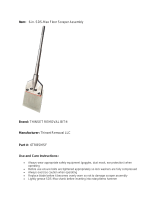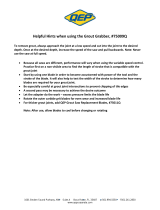
Thinset and Adhesive
The adhesive used to install Bodesi glass tile is critical to a successful installation. Ordinary thinsets that are suitable for
ceramic or porcelain may not be used for glass tile installation. For glass tile it is required to use a modied thinset. This
means that there is a polymer or other additive that has been added to the formula in order for the maintain somewhat
pliable or elastic characteristics of the adhesive. This prevents cracking and ensures a positive installation.
Because glass may have translucent properties, we advise to use high quality adhesives. Adhesives can vary in whiteness
and color consistency. The following adhesives have the correct properties for installation of our glass tile in interior/
exterior and dry and/or intermittently wet ares such us showers and bathtub surrounds and even saunas and spas. For
underwater and pool applications please contact us or refer to your pool specialist for advice. For large projects that
require multiple bags, a product with batch controlled for bag to bag consistency should be chosen.
Suitable Thinsets
The following thins set mortars are suitable for most applications.
Please refer to the instructions and specications on the packaging for details.
Proper procedures must be used to acquire professional results.
CUSTOM BUILDING PRODUCTS: Glass Tile Premium Thin-Set
MAPEI: Adesilex P10 Bright White Thin-Set Mortar mixed with Keraply Mortar Additive
ARDEX: X77 Tile & Stone Mortar
BOSTIK: Glass-Mate mixed with 425 Admixture
LATICRETE: Glass Tile Adhesive
TEC SPECIALTY PRODUCTS: Super Flex Thin-Set Mortar * Bright White † Color controlled bag-to-bag consistency.
Organic adhesives such as mastic are not recommended as they are water based and may fail in certain applications.
Contact installation support for recommendations at 1 888 658 2488
Crack Isolation Membrane
Just as it sounds, crack isolation membranes create protective layer
between tile and the substrate they are installed on. These are usually
used on larger installations and or in wet areas such us showers or
spa’s. Some substrates can shift, warp, and deect with heat or with
age, it is advisable to use a crack isolation membrane to prevent
cracking of the glass tile. There are various products available,
please make sure to consult the membrane manufacturer for specic
applications limitations and installation uses.
GLASS TILE STUDIO
Use, Care and Maintenance
Substrate
Substrate refers to the material that the tile is actually adhered to. For most common application such as backsplashes this
would be drywall. Other applications such as showers or commercial applications may have concrete or cement backer
boards etc. Each substrate should be clean, dry and cured before installation begins.
There are 3 types of acceptable substrates for Bodesi Glass Tile products:
Concrete – Cured a minimum of 30 days, Surface must be at and smooth and may require surface repair
Cement Backer Board (CBU) – Hardibacker, Durrock, Fiberock,, PermaBase, Wonderboard.
Drywall – Dry locations are suitable for backsplashes or other small dry areas. Make sure it is dry, at and clean.
In any case of substrate the installer should be well versed with e the substrate preparation and requirements as set out by
the TCNA (Tile Council of North America
CUSTOM BUILDING PRODUCTS: RedGard
MAPEI: Mapelastic AquaDefense
LATICRETE: Hydro Ban
BOSTIK: GoldPlus
TEC SPECIALTY PRODUCTS: HydraFlex
ARDEX: 8+9






